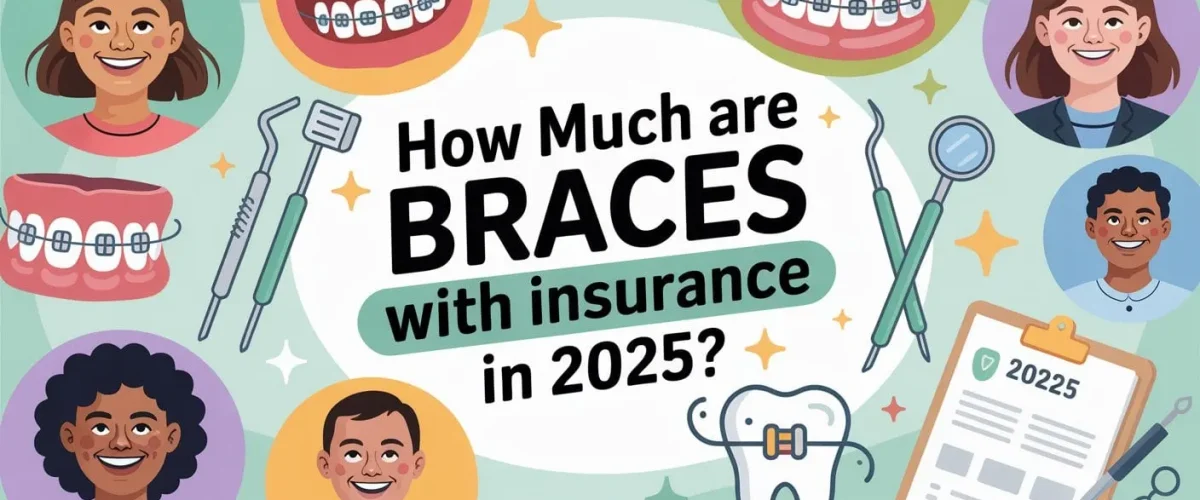Braces in 2025 aren’t what they used to be. From sleek aligners to tech-fueled treatment planning, orthodontics has leveled up—but so have the bills. If you want to know how much braces cost with insurance, it depends on your age and plan. It also depends on how well you understand your provider.
How Much Are Braces With Insurance in 2025?
Braces with insurance in 2025 typically cost $1,000 to $3,500 out-of-pocket, depending on the type of treatment and your plan. Insurance usually covers 25% to 50% of the total cost—often capped by a lifetime maximum of $1,500 to $3,500. Coverage is often better for kids than for adults. Insurers usually support traditional metal braces the most.
Let’s untangle the numbers, crush the jargon, and break down exactly how much braces cost with insurance in 2025.
Why Insurance Is the Game-Changer for Braces
Without insurance, braces can cost as much as a used car. With it? You could slash your bill in half.
Most insured patients pay between $1,000 to $3,000 out-of-pocket, compared to $4,000 to $8,000 for the uninsured. That’s not just pocket change—it’s the difference between budgeting and burning out your savings.
Coverage for Kids Is Still the Gold Standard
Dental insurance plans tend to favor the under-18 crowd. Most policies cover 25% to 50% of a child’s treatment, usually capped by a lifetime maximum of $1,500 to $3,500. That means if your kid’s braces cost $5,000, you might only owe $2,500.
Some higher-end policies go even further—especially those that understand early orthodontic care can prevent bigger issues later.
Adult Braces? Covered, But With Caveats
| Type of Braces | Total Cost (No Insurance) | Estimated Cost With Insurance | Typical Insurance Coverage |
|---|---|---|---|
| Metal Braces | $3,000 – $7,500 | $1,500 – $3,750 | 50% (most plans) |
| Ceramic Braces | $4,000 – $8,500 | $2,000 – $4,250 | 25–50% (may be reduced) |
| Lingual Braces | $6,000 – $13,000 | $3,000 – $6,500 | 20–50% (limited plans only) |
| Clear Aligners (e.g. Invisalign) | $3,000 – $8,500 | $1,500 – $4,250 | 25–50% (varies by plan) |
Next up, we break down each option in more detail—starting with the old-school MVP…
Traditional Metal Braces: Most Covered, Least Glamorous
Now for the grown-ups. If you’re over 18, brace yourself (pun intended): coverage is less generous. Plans that provide adult benefits usually limit them to between $1,500 and $3,000. Many also need proof that the treatment is medically necessary, not just for cosmetic reasons.
Still, more plans are stepping up. Delta Dental‘s 2025 overview says their premium plans cover 50% after a $50 deductible, even for adults.
Quick Snapshot: Braces Costs in 2025 (With and Without Insurance)
| Type of Braces | Total Cost (No Insurance) | Estimated Cost With Insurance |
|---|---|---|
| Metal Braces | $3,000–$7,500 | $1,500–$3,750 |
| Ceramic Braces | $4,000–$8,500 | $2,000–$4,250 |
| Lingual Braces | $6,000–$13,000 | $3,000–$6,500 |
| Clear Aligners | $3,000–$8,500 | $1,500–$4,250 |
Traditional Metal Braces: Most Covered, Least Glamorous
Metal braces might not win beauty contests, but they win at coverage. Insurance companies still view them as the most needed. This means they are more likely to get full support.
In most cases, you’ll pay half the total bill, which puts you in the $1,500–$3,750 range. Bonus: these braces often work faster, which can save money on appointments.
Ceramic Braces: Discreet but Pricey
Ceramic braces are the glow-up version of metal ones—same function, sleeker look. But that aesthetic upgrade adds dollars.
Insurance usually covers metal braces. However, ceramic braces cost more at first, between $4,000 and $8,500. This means you pay more out of pocket, around $2,000 to $4,250.
Some insurers use an alternate benefit clause. This means they will only cover the cost of metal braces, and you pay the rest.
Lingual Braces: Invisible but Painful… on the Wallet
Brackets on the back of your teeth? Very chic. Very pricey. Lingual braces range from $6,000 to $13,000, and insurance sometimes shrugs them off as cosmetic.
Even with a 50% reimbursement, you could still owe $3,000 to $6,500. Ouch—unless your plan is super generous.
Clear Aligners (Invisalign, Spark): Coverage Has Entered the Chat
The glow-up of 2025 is the expanded insurance coverage for clear aligners. Plans now increasingly treat them like traditional braces.
You should check your plan’s details. Insurers like Cigna Dental now include Invisalign in their orthodontic benefits. Expect to pay $1,500 to $4,250, depending on coverage levels and plan type.
Why Lifetime Maximums Matter More Than You Think
Orthodontic benefits don’t reset yearly—they cap out at a lifetime maximum. Most hover between $1,500 and $3,500. That’s your orthodontic allowance for life under that plan.
If you’ve used it up as a teen, don’t expect a reset as an adult. Plan ahead—especially if you’re switching providers or adding kids to your policy.
Medicaid Braces Coverage for Kids (Spoiler: Yes, It’s a Thing)
If your child is covered by Medicaid, braces may be included if medically necessary. Each state sets its own definition, but functional problems like overbites and jaw issues typically qualify.
This is especially important for families balancing limited income with long-term care. Read more via Parsons Orthodontics.
Employer Plans vs. Individual Plans: Which Pays Better?
Generally, employer-sponsored plans win. If you’re wondering how much are braces with insurance through your job versus a private plan, the gap can be significant. Employer plans usually provide higher maximum benefits and better coverage percentages. Some even include adult orthodontics, which is rare in individual policies.
Looking for an individual plan? Denali Dental ranked high for value and orthodontic options in 2025, especially if your employer’s plan is lacking.
Add-On Orthodontic Riders: Worth It?
Some insurers offer orthodontic “riders”—add-ons that boost your basic coverage. These can mean higher payout percentages or broader treatment type eligibility.
For example, MetLife’s FEDVIP High Option covers adult braces at 50% up to $3,000. No waiting period. No excuses.
Financing Braces in 2025: It’s Not Just Credit Cards
Still sticker-shocked? Even if you have insurance, knowing how much braces cost with insurance helps you plan for what your policy won’t cover. Most orthodontists offer in-house monthly payment plans, usually interest-free.
Other options include:
- FSAs and HSAs: Use pre-tax dollars to cut your cost by up to 30%.
- Ortho schools: Supervised students = discounted care (if you have time to spare).
- Third-party lenders: Just be wary of high interest rates.
Timing Your Treatment = Bigger Savings
Some plans have waiting periods before orthodontic benefits kick in—anywhere from 6 months to a year. Starting too early could cost you thousands.
Pro tip: Sync treatment with your plan’s benefit period, not just the calendar year. It can double your effective coverage.
In-Network vs. Out-of-Network: This One Detail Can Cost You Thousands
Orthodontists in your insurance network have pre-negotiated rates. Go out-of-network, and you’ll pay the difference out of pocket—sometimes thousands more.
Call your provider before booking a consultation. Better yet, ask for a pre-treatment estimate in writing.
What to Watch for in 2025 and Beyond
Trends to keep an eye on:
- More coverage for aligners as they become standard
- AI-powered planning tools reducing treatment time
- Increased adult demand, especially among 30-somethings
According to SmileWorks NYC, insurance companies are adjusting—slowly but surely—to meet this shift.
Bottom Line: Insurance Helps, but You Still Need Strategy
Insurance isn’t a magic wand, but it can save you thousands if you play it smart. Know your lifetime maximums, get that pre-auth, and keep your provider’s number handy. Whether you’re a teen, a parent, or finally fixing that crooked smile at 35—2025’s orthodontic market has options.
Just don’t expect them to be cheap without a plan.




